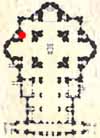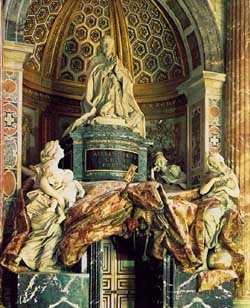 |
| Grottoes
Vatican City Colonnade Saints Floorplan #2 |
| Altars
Monuments The History |
| Related
Sites Alexander VII |
|
This, one of the most famous papal monuments in St. Peter's, is the masterpiece of the 80-year old Bernini. The door under the monument leads to an exit of the basilica. Alexander VII was the pope who commissioned Bernini to enclose St. Peter's Square with the colonnade. |
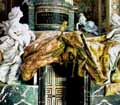
|
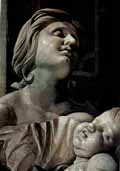 |
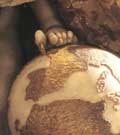 |
 |
From: 'St. Peter's - Guide to the Basilica and Square'
Opposite and on the right, is the famous monument of Alexander VII (1655-1667),
the last great masterpiece of the 80-year old Bernini who was assisted
by various artists. The Pontiff, kneeling and absorbed in prayer, is not
disturbed by the sudden appearance of Death, who, raising a heavy pall,
brandishes an hour-glass to indicate that time has passed. The four statues
represent the virtues practiced by the Pontiff: in the foreground is Charity
by G. Mazzuoli, with a child in her arms, and Truth, by Morelli and Cartari,
who sets a foot on a map of the world, and precisely on England where
the Pope sought in vain to quell the growth of Anglicanism; on the second
level is Prudence, by G. Cartari, and Justice, by L. Balestri.
The skeleton of Death is in gilded bronze; the splendid drapery which conceals part of the door under it is made of Sicilian jasper; the statues are carved in white marble and the plinth in black, as a sign of mourning.
From:
'St. Peter's Basilica - A Virtual Tour' by Our
Sunday Visitor
... on the outside wall, there is the Monument to Alexander VII, completed
in 1678 by Bernini, at the time almost 80 years old, who created a masterpiece
emblematic of Baroque and of the art of funeral monuments.
With ingenious theatricality, he solved the problem of the pre-existent door, leading to the St. Mary Chapel and then out of the Basilica. This door was transformed into a symbolic entrance to Eternity, by means of the scenographic device of swelling draperies created in Sicilian Jasper, raised by a skeleton holding an hour-glass, extreme sign of Death.
The many colors of this work, rich in precious marble including breccia marble of the seven bases is completed by the gilded stucco of the vault. There is therefore an effective contrast between this and the white marble of the allegorical figures, Charity with a plump child and Truth, whose nudity was covered by order of Innocent XI.
The serene figure of the Pope in prayer rises above, not in the least disturbed by the unavoidable call from the beyond by the skeleton. The treatment of his majestic cope is refined and effective. It is the work of Domenico Bassadonna, who admirably exploited the veining of the marble to render the streaks of cloth. Bernini provided clay models and water-color sketches of this monument and had a full size model built before the actual work was carried out.
From:
'THE NEW SAINT PETER'S'
In the aisle, on the right, we come upon another masterpiece of Bernini:
the monument of Alexander VII Chigi (1655-1669), a work which belongs
to the last period of the artist's activity. The Pope is portrayed kneeling
between Justice, Prudence, Charity and Truth, by G. Mazzoli. The last
of the figures, originally nude, was covered by a metal drapery by Bernini
himself, at the command of Innocent XI. We can notice some defects of
composition, and the various parts of the work betray the hands of several
sculptors. Charity, were it not marred by its covering, would be an important
work.
From: Bernini
and the Art of Architecture by Tod A. Marder. Abbeville Press (October
1, 1998)
Like Urban VIII, Alexander VII also commissioned Bernini to design his
tomb in Saint Peter's, but unlike his predecessor, Alexander did not ensure
the beginning of the work before his death, nor was the project pursued
under his successor Clement IX. Instead, the work was begun in 1672 during
the reign of Clement X and dedicated only in 1678 during the pontificate
of Innocent XI, extending through no fewer than four papacies. Alexander's
tomb is located over a door called Porta Santa Marta at the extreme southwest
of the basilica.
Recent critics have endorsed the reading of Alexander's tomb as a projection of a three-dimensional scheme inserted in a niche that was the only appropriate site remaining in Saint Peter's. The concept of the monument, worked out with the pope's involvement, was initially to include the meeting of Modesty and Truth and the embrace of Justice and Peace. It was subsequently deemed more appropriate to insert Prudence in place of Peace, and Charity for Modesty, no doubt to avoid the impression that Alexander's foreign policy had been too accommodating. To strike the proper note of piety and strength was essential for the success of the ensemble, which sought to memorialize the pope's spiritual and temporal authority. Showing the pope in prayer rather than in a gesture of benediction emphasized his spiritual power. By mounting the effigy on a base rather than a sarcophagus, Bernini and his patron conflated the tradition of a royal tomb effigy with that of the papal honorary statue. And to underscore the propriety of the imagery, the naked figure of Truth was given a billowing cloak, mnaufactured in lead, applied in situ, and painted white to resemble marble.
None of the preparatory drawings for the tomb utilize the scheme of the doomed interior, which must be understood as a crucial addition to earlier thoughts for the ensemble. Kaspar Zollikofer points out that the dome is articulated in a manner strikingly similar to those over the central churches of Sant'Andrea al Quirinale, Santa Maria dell'Assunzione at Ariccia, and San Tommaso di Villanova at Castel Gandolfo, and the blue field that denotes the oculus recalls Alexander's interest in remodeling the Pantheon. An inscription around the oculus of the Pantheon's dome on a project for its embellishment indicates that it too was foreseen as a possible memorial to the deceased Chigi pope, though the drawing is not by Bernini.
From: 'BERNINI'
Copyright © 1997 by Rudolf Whittkower, p. 295-6
The commission for the tomb was given by Alexander himself. After his
death Cardinal Flavio Chigi became the executor of his uncle's estate.
Alexander's successor, Clement IX, wanted the tomb to be erected in the
choir of S. Maria Maggiore.
In 1670, shortly after the death of Clement IX (1669), the idea of erecting the tomb in S. Maria Maggiore was abandoned together with Bernini's plans for reconstructing the choir and a place in St Peter's was chosen. The choice fell on a relatively narrow passage of the south transept where the tomb had to be fitted into a niche containing a door, which Bernini brought forward. A fresco by Romanelli had to be transferred.
The present tomb is one of the greatest combined enterprises of Bernini's studio. Bernini himself made drawings and a small model of the whole tomb. On 7 October 1672 he received 1,000 scudi for the design and model. A preliminary design, made in the studio, incorporating theprincipal features of the tomb, survives in the Royal Library at Windsor.
Bernini himself had a hand, at least, in the statue of the Pope: he probably put the finishing touches to the face. Charity was carried out by Giuseppe Mazzuoli between May 1673 and November 1675; Truth first by Lazzaro Morelli between November 1673 and December 1674, when the figure was handed over to Giulio Cartari, Bernini's favourite, who finished it between April and November 1675. Michele Maglia, a Romanized Frenchmaan, was responsible for the figure of the Pope.
The figure of Death caused particular difficulties. Between May and July 1676 Morelli was concerned with adjusting the model in the final position. Greatest care was taken with the shroud, which was tackled beore the figures were begun. Morelli executed it in travertine and, from May 1673 onwards, the stonemason Gabriele Renzi covered this foundation with coloured marble ('diaspro di Sicilia').
Early in 1678 the tomb was practically finished. It was then that Pope Innocent XI objected to the nakedness of Truth and Bernini was obliged to 'dress' the figure. The figure of Charity, too, had originally bare breasts as shown in the Siena bozzetto.
From:
'The Deaths of the Popes' ©
2004 by Wendy Reardon
Fabio Chigi died at age 66 from kidney failure. He kept his coffin
in his bedroom, and a skull (carved by famed sculptor Gian Lorenzo Bernini)
on his writing table, because he was always aware that he would someday
die.
A seventeenth century pamphlet credited to Philip Ayers, titled A Short Account of the Life and Death of Pope Alexander VII, contains many fascinating details about Alexander's passing. According to this pamphlet, Alexander, although bedridden, wanted to celebrate the Passion to ready himself for his impending death. Neither his surgeon nor his confessor was able to persuade him to save his strength. He blessed the large crowd of people on Easter day, the last time they would ever see him alive.
